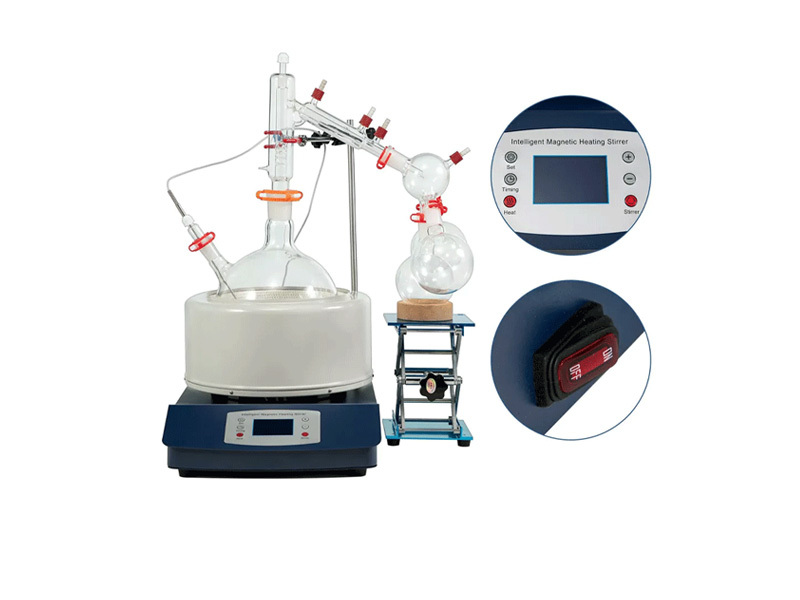Three modes of laboratory cannabis short-path distillation equipment
Release Time:
2022-12-05
Pageviews:
1. Molecules diffuse from the liquid phase body to the evaporation surface:
Usually, the diffusion speed in the liquid phase is the main factor controlling the molecular distillation speed, so the thickness of the liquid layer should be reduced as much as possible and the flow of the liquid layer should be strengthened.

2. Free evaporation of molecules on the surface of the liquid layer:
The evaporation rate increases with the increase of temperature, but the separation factor sometimes decreases with the increase of temperature. Therefore, an economical and reasonable distillation temperature should be selected on the premise of the thermal stability of the processed substance.
3. Molecules fly from the evaporation surface to the condensation surface:
In the process of flying from the evaporating surface to the condensing surface, the steam molecules may collide with each other, or collide with the remaining air molecules between the two surfaces. Because evaporated molecules are much heavier than air molecules, and most of them have the same direction of motion, their own collisions have little effect on the direction of flight and evaporation speed. The residual gas molecules are in a chaotic thermal motion state between the two sides, so the number of residual gas molecules is the main factor affecting the flying direction and evaporation speed.
Three modes of laboratory cannabis short-path distillation equipment
1. Molecules diffuse from the liquid phase body to the evaporation surface:
Usually, the diffusion speed in the liquid phase is the main factor controlling the molecular distillation speed, so the thickness of the liquid layer should be reduced as much as possible and the flow of the liquid layer should be strengthened.
2. Free evaporation of molecules on the surface of the liquid layer:
The evaporation rate increases with the increase of temperature, but the separation factor sometimes decreases with the increase of temperature. Therefore, an economical and reasonable distillation temperature should be selected on the premise of the thermal stability of the processed substance.
3. Molecules fly from the evaporation surface to the condensation surface:
In the process of flying from the evaporating surface to the condensing surface, the steam molecules may collide with each other, or collide with the remaining air molecules between the two surfaces. Because evaporated molecules are much heavier than air molecules, and most of them have the same direction of motion, their own collisions have little effect on the direction of flight and evaporation speed. The residual gas molecules are in a chaotic thermal motion state between the two sides, so the number of residual gas molecules is the main factor affecting the flying direction and evaporation speed.
Latest News
2024-09-03
Abstract: Oil deacidification is an important step in food processing, which aims to remove free fatty acids in oil and improve its quality and stability. Traditional deacidification methods have some limitations, such as low efficiency, high energy consumption, and loss of nutrients. In recent years, molecular distillation technology has gradually attracted attention as a new deacidification method. This article will introduce the application of molecular distillation in oil deacidification, including the principle, operation process and advantages, and focus on the outstanding advantages of Aishengke in molecular distillation technology.
Vitamins are products that are closely related to people's lives, and have become one of the main bulk products in the international pharmaceutical and health care products market. The amount of vitamin E is the largest, followed by vitamin A, vitamin C, vitamin D and so on. With the growth of economy and the improvement of people's living standards, the demand for vitamin products will further increase, and people's requirements for their quality and grade will also further increase. Therefore, as an important separation technology in the production of many vitamins, molecular Distillation technology will also play an increasingly important role in the vitamin industry.
Glyceryl monostearate (GMS), abbreviated as monoglyceride, is produced from natural vegetable oils and fats. The active ingredient is purified by molecular distillation technology to more than 90%, also known as molecular distillation monoglyceride. It is the most widely used food Additives, safe to use in the production and processing of food, medicine, plastics, etc., account for more than half of the emulsifier consumption in the market.
The principle of molecular distillation is to make use of the different degrees of affinity between different molecules. By controlling the conditions such as temperature and pressure, the mixture begins to vaporize. Different components in the vapor form liquids in the condenser and are separated according to their boiling points. This distillation method not only has a good separation effect, but also can be repeatedly separated and purified, and is widely used in chemical, pharmaceutical and other fields.
Molecular distillation is a common chemical method used to separate and purify compounds. In the pharmaceutical industry, molecular distillation is widely used in pharmaceutical purification. This article will focus on the application of molecular distillation in pharmaceutical purification and provide some specific examples.
Laboratory vacuum distillation equipment has undergone significant advancements in recent years, driven by the need for higher efficiency, improved safety, and enhanced user experience.
Global recruitment of distributors
If you recognize the brand, technology, products and market prospects of Aishengke, we look forward to establishing a strategic partnership with you for win-win cooperation and development. Looking forward to your joining!

